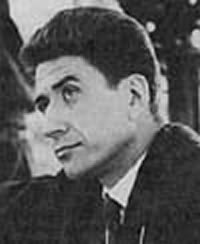
|
Filmmakers
|
 |
|
|
 ALAIN RESNAIS
ALAIN RESNAISIn his first feature film Hiroshima mon amour (1959), we already find the themes which will haunt a large segment of his work: love and death, memory and forgetting, and the interweaving of past and present (if not the future). The film won numerous prizes and turned Resnais into an international celebrity virtually overnight. His following film Last Year at Marienbad (L’Année dernière à Marienbad, 1961) won the Golden Lion at the Venice Film Festival and the prestigious Meliès Prize in France. It both fascinated and confounded the public with its mysterious characters and enigmatic plot. A banal story of adultery — a man tries to lure a woman away from her husband — is transformed into a dream-like (or better, nightmarish) ceremony, a succession of phantasmal events whose meaning is elusive.
Next, in Muriel, or The Time of Return (1963), Resnais returns to his meditations on the problem of time in human relations, as well as on the problem of war, themes that he had treated in Hiroshima. In Boulogne a woman who receives a visit by a former lover (their affair dated from the Second World War period) is forced to accept the fact that the effects of time have separated them irremediably. At the same time the woman’s stepson, who has just returned from military service in Algeria, tries to face his anguished memory of the acts committed by the French soldiers during the war there.
Resnais’s following film The War is Over (1966) is a reflection, as Marcel Ohms says, of “the existential problems of political struggle.” The hero is an underground militant of the Spanish Communist Party living in exile in France. He experiences an identity crisis during which he questions whether his struggle against Franco’s government is still worthwhile. Here again past and present are confronted as the political militant realizes that he may be living in a past whose realities are not pertinent to the present situation.
In Je t’aime, je t’aime (1968) Resnais treats familiar subjects in a new manner: as science fiction. Returning once again to the themes of death and the problems of memory — as well as the frequent dream-like climate of his films — he offers us the story of a man who, following a failed suicide attempt, participates in a scientific experiment in which he is sent back into his own past. When the machine goes awry, the order of his memories is upset.
The following film Stavisky (1974) is probably the most atypical of Resnais’s films by its realism and its apparent conventionality — despite a certain unreality produced by the depiction of an extremely opulent world. It is also one of his most “politicized” films. Resnais offers a half-historical, half-fictional version of the “Stavisky Affair,” the story of a huge swindle which was all over the news at the beginning of 1934. It had deep repercussions for some of the most prominent political figures in France.
Providence (1976), a film which won the Cesar for the Best Director at Cannes in 1978, treats both the problem of aging and death, as well as that of artistic creation. We follow the anguished phantasms of the main character, an aging writer who intertwines in his nightmares the members of his family and the characters of his next novel. His phantasms are profoundly influenced by his bad conscience, his fear of growing old, and his obsession with death.
In My American Uncle (1980), which won the Oscar for the Best Foreign Film, Resnais tells the story of three lives, of three individuals from very different social strata whose destinies intermingle. In addition to the three narratives which retrace the paths of the three main (fictional) characters, the film contains a fourth “narrative,” a scientific discourse which is produced by a non-fictional character, Professor Henri Laborit. A scientist sharing his thoughts with us as he works in his laboratory, Laborit develops hypotheses based on behavioral biology and psychology. His observations serve, to a certain extent, as a commentary on the actions and reactions of the fictional characters.
Resnais will continue to make films during the next quarter century, consistently exhibiting a taste for experimentation which will lead him to try a variety of genres, like pure melodrama in Mélo (1986) or the use of dialogue which is entirely sung in Same Old Song (1997).
Selected Filmography (feature films)
1959 Hiroshima mon amour
1961 Last Year at Marienbad
1963 Muriel, or the Time of Return
1966 The War is Over
1968-69 Je t’aime, je t’aime
1973-74 Stavisky
1976 Providence
1980 My American Uncle
1983 Life is a Bed of Roses
1984 Love Unto Death
1986 Mélo
1989 I Want To Go Home
1993 Smoking No Smoking
1997 Same Old Song
2003 Not on the Mouth